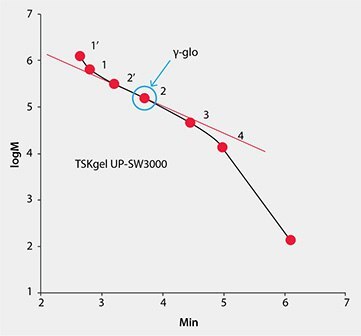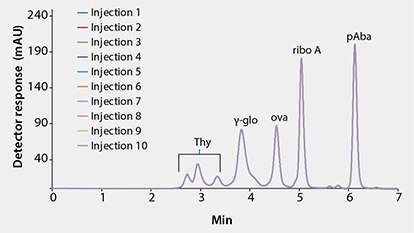2 Micron SEC Column with Dual Functionality for Use in UHPLC and HPLC Systems
Phu Duong
Reporter US Volume 34.2
Size Exclusion Chromatography (SEC) is an important method for monitoring the impurities of biotherapeutic drugs, in order to minimize the immunologic effect that may occur when such impurities are present. The SEC method is widely used to determine the monomers, dimers, aggregates, and fragments in biotherapeutic drug samples, including monoclonal antibodies (mAbs). A few of the requirements for a successful analysis include: superior resolution, excellent reproducibility and short analysis time. In order to achieve these, an SEC column must have the appropriate particle size and pore size, good bonding chemistry, and suitable column dimensions. To ease method development, SEC columns can be run using an established operating method with minimal time spent on method optimization. To enhance cost-saving measures, these columns should be packed such that they can be operated with both HPLC and UHPLC systems.
TSKgel® UP-SW3000 SEC columns have a particle size of 2 μM, and are 25 nm in size. The particles are coated with a hydrophilic diol-type bonded phase in order to minimize the interaction between the silica surface and proteins. These columns are designed to be operated with a simple and well established method (sodium phosphate mobile phase, pH 6.8) and are packed for use in both HPLC and UHPLC systems. Offering high resolution, improved peak shape and no pressure limitations when used with UHPLC systems, TSKgel UP-SW3000 columns are optimized for the analysis of monoclonal antibodies.
Figure 1 shows the protein standard calibration curve data that was generated using the TSKgel UP-SW3000 column. The column was run with a simple aqueous mobile phase (sodium phosphate buffer, pH 6.8) as typically reported in literature for SEC separations. The data demonstrates that the TSKgel UP-SW3000 column has a broad and linear resolving range of molecular weights. The shallow slope around the molecular weight of γ-globulin suggests that the particles of the column have an optimized pore size for the separation of proteins with a molecular weight of approximately 150 kDa.

Figure 2 shows comparison data between a TSKgel UP-SW3000 column for mAb analysis versus the use of a 5 μM particle sized TSKgel G3000SWXL column. The TSKgel UP-SW3000 column offers higher resolution of both the high molecular weight (HMW) species and the Fab/c on the low molecular weight side. In addition, the analysis was completed in half the run time since the TSKgel UP-SW3000 column was used on a UHPLC system. A method developed on a conventional HPLC system using a TSKgel UP-SW3000, 2 μM column is smoothly transferrable to a UHPLC system. Two separation profiles of a QC protein standard mixture using a TSKgel UP-SW3000 column from an HPLC and UHPLC system are shown in Figure 3.

Figure 2.Comparison of mAb Analysis Using TSKgel G3000SWXL and UP-SW3000 Columns

Figure 3.Analysis of QC Protein Standards Using a TSKgel UP-SW3000 Column on an HPLC and a UHPLC System
Figure 4 shows the elution profile of a QC protein standard mixture generated using a TSKgel UP-SW3000, 15 cm x 4.6 mm I.D. column operated at 0.35 mL/min. The separation was completed in only 7 minutes, nearly 2 times faster than the same column of 30 cm × 4.6 mm I.D. dimension. The peak resolution profile remained nearly unchanged. In particular, the resolution profile of thyroglobulin was similar to the resolution that was obtained by the 30 cm x 4.6 mm I.D. column. This suggests that the separation of high order molecular weight species, such as aggregates from mAb, can be easily achieved using this 15 cm x 4.6 mm I.D. column. Ten consecutive runs yielded excellent reproducibility. In fact, peaks from 10 consecutive injections were nicely overlaid.

Figure 4.10 Consecutive Injections of QC Protein Standard Mixture Generated Using a TSKgel UP-SW3000 Column
Results from Table 2 show low percentage relative standard deviation of the theoretical plates from a wide range of molecular weights within 10 consecutive injections of protein standard (from Figure 4). The data suggests that the TSKgel UP-SW3000 columns have a high reproducibility of injection after injection.
The above results demonstrate the broad and linear molecular weight resolving range of TSKgel UP-SW3000 columns. This, in turn, drives the accuracy, reliability and reproducibility for molecules of interest such as the monomer, dimer, and aggregates of mAbs. The comparison between a TSKgel UP-SW3000 column and a larger particle sized SEC column using the same operating mobile phase conditions showed that the TSKgel UP-SW3000 column has higher resolution. This suggests that the TSKgel UP-SW3000 column can be easily operated with an established method. The low backpressure allows TSKgel UP-SW3000 columns to be run in both HPLC and UHPLC systems. With the shorter column dimension that is available, faster analysis time can be achieved for increased sample throughput.
To continue reading please sign in or create an account.
Don't Have An Account?